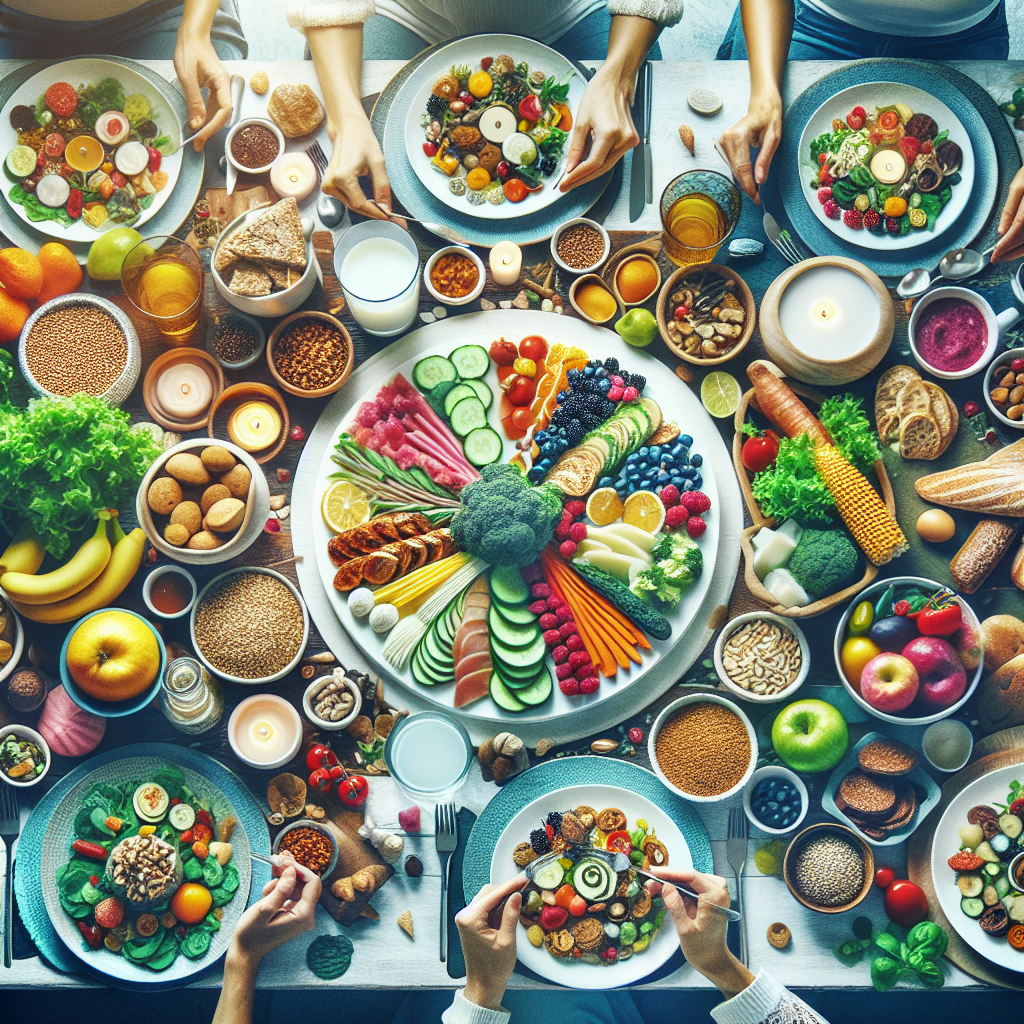Escape the stress and anxiety often associated with social gatherings by incorporating mindful eating into your experience. Tastepan’s collection of nutritious and delicious recipes empowers you to prioritize your well-being while enjoying the company of loved ones. Discover the art of savoring every bite and engaging all your senses, as you nourish your body without sacrificing flavor. With expert advice and dietary tips, Tastepan makes healthy eating a breeze, ensuring that you can fully embrace the joy of social settings and create lasting memories with those around you.

1. Mindful Eating in Social Settings
When it comes to eating in social settings, practicing mindful eating can help you fully enjoy your meals while also taking care of your health and well-being. Mindful eating is all about being present in the moment and paying attention to your body’s hunger and fullness cues. By understanding the principles of mindful eating, you can experience its numerous benefits and apply them to social situations.
1.1 Understanding Mindful Eating
Mindful eating involves being fully present and engaged during your meals. It means eating with intention, paying attention to the sensory experience of eating, and acknowledging your body’s hunger and satisfaction levels. Instead of mindlessly consuming food, mindful eating encourages you to savor each bite and tune in to your body’s needs.
1.2 Benefits of Mindful Eating
Practicing mindful eating brings a wide range of benefits. By being more aware of your body and its signals, you can develop a healthier relationship with food and make better choices. Mindful eating can help prevent overeating, improve digestion, enhance your appreciation for food, and promote a greater sense of well-being. It can also reduce stress and improve your overall mindfulness in daily life.
1.3 Applying Mindful Eating in Social Settings
Social gatherings often involve food, and practicing mindful eating in these settings is equally important. It can help you navigate the various temptations and maintain a balanced approach to eating. Applying mindful eating in social settings involves planning ahead, preparing nutritious meals, using mindful eating techniques, and handling social pressures with grace and confidence.
2. Planning Ahead
To set yourself up for success in social settings, it’s helpful to plan ahead and make conscious choices regarding menu selection, portion control, healthy recipe ideas, and accommodating dietary restrictions.
2.1 Menu Selection
When attending a social gathering, take a look at the menu or inquire about the available food options. Look for dishes that align with your dietary preferences and goals. If you have specific dietary restrictions, communicate them politely to the host or offer to bring a dish that fits your needs.
2.2 Portion Control
Portion control plays a crucial role in maintaining a well-balanced and mindful approach to eating. Before serving yourself, assess the portion size that will satisfy your hunger without leading to overeating. Use smaller plates and bowls to help manage portion sizes and prevent mindless munching.
2.3 Healthy Recipe Ideas
If you’re responsible for preparing a dish for the gathering, choose healthy recipes that are both delicious and nutritious. Incorporate fresh fruits and vegetables, whole grains, lean proteins, and healthy fats into your recipes. This way, you can contribute to the event while enjoying a meal that aligns with your mindful eating goals.
2.4 Accommodating Dietary Restrictions
Be mindful of the dietary restrictions of others when hosting a social gathering. Provide a variety of food options that cater to different dietary needs such as vegetarian, vegan, gluten-free, or dairy-free. By accommodating various dietary restrictions, you ensure that everyone can enjoy the meal and feel included.

3. Preparing for the Gathering
Preparing for a social gathering involves mindful grocery shopping, meal prepping, and choosing cooking techniques that preserve the nutritional value of the food.
3.1 Mindful Grocery Shopping
When grocery shopping for the gathering, make a list of the items you need and stick to it. Avoid impulse buying and focus on purchasing fresh, high-quality ingredients. Read food labels and opt for minimally processed foods that support your mindful eating goals.
3.2 Meal Prepping
To minimize stress and save time on the day of the gathering, consider meal prepping in advance. Chop vegetables, marinate meats, or prepare any dishes that can be made ahead of time. This allows you to focus on mindful preparations during the event and reduces the risk of feeling overwhelmed.
3.3 Choosing Mindful Cooking Techniques
Opt for cooking techniques that preserve the nutritional value of the food while enhancing the flavors. Steaming, grilling, roasting, and sautéing with minimal oil are great options. Avoid deep-frying or excessively seasoning dishes, as this can mask natural flavors and potentially lead to overeating.
4. Mindful Eating Techniques
During the social gathering, apply various mindful eating techniques to fully enjoy your meal and stay attuned to your body’s signals.
4.1 Slow and Savory
Take your time to eat and chew your food slowly. This allows you to savor the flavors and textures of each bite. Eating slowly also gives your brain enough time to register when you’re feeling satisfied, helping prevent overeating.
4.2 Portion Awareness
Be mindful of your portion sizes and serve yourself moderate portions initially. Take small breaks during the meal to assess your hunger and fullness levels. If you’re still hungry, go for a second serving, but do so mindfully, paying attention to the taste and satisfaction it brings.
4.3 Savoring Flavors
Engage all your senses while eating. Notice the aroma, appearance, and taste of the food. Appreciate the effort that went into its preparation and the joy it brings. By fully immersing yourself in the flavors, you can enhance the overall sensory experience of the meal.
4.4 Mindful Chewing
Chew each bite thoroughly and focus on the taste and texture of the food. Chewing your food well aids digestion and allows you to fully enjoy the flavors. It also helps you eat more mindfully, as you’re less likely to rush through your meal.
4.5 Engaging Conversations
While it’s essential to be mindful of your eating, also remember to engage in meaningful conversations. Focus on connecting with fellow attendees and building relationships. By balancing mindful eating with engaging conversations, you can maximize your enjoyment of the social gathering.

5. Handling Social Pressures
Social settings often come with social pressures when it comes to food choices. Here are strategies to overcome peer influence, deal with food pushers, and politely decline unwanted offers.
5.1 Overcoming Peer Influence
In social settings, it’s common for others to influence your food choices. Stay true to your mindful eating goals by politely declining unhealthy options or excessive portions. Remember that your well-being is a priority, and it’s okay to make choices that align with your values.
5.2 Dealing with Food Pushers
Some individuals may persistently offer you food or push you to eat more than you’re comfortable with. In such situations, assertively but kindly assert your boundaries. Express gratitude for their offer but politely decline, emphasizing your mindful eating approach and the importance of honoring your body’s needs.
5.3 Polite Decline Strategies
When faced with unwanted offers or temptations, it helps to have polite decline strategies in place. You can respectfully decline by saying, “Thank you for offering, but I’m satisfied,” or “I appreciate your thoughtfulness, but I’m trying to make mindful choices for my well-being.”
6. Mindful Drinking
In social settings, it’s crucial to extend mindful eating principles to your beverage choices. Focus on hydration, make mindful beverage selections, and practice moderation and enjoyment.
6.1 Hydration and Alcohol
Staying hydrated is essential, especially in social gatherings where alcoholic beverages may be present. Alternate alcoholic drinks with water or choose low-sugar, hydrating options such as infused water or herbal teas. Keeping yourself properly hydrated supports your overall well-being.
6.2 Mindful Choices for Beverages
When selecting beverages, consider options that align with your mindful eating goals. Opt for drinks with lower sugar content, such as unsweetened iced tea or sparkling water. Be mindful of portion sizes, especially when it comes to sugary drinks or alcoholic beverages.
6.3 Moderation and Enjoyment
In social settings, it’s important to strike a balance between enjoying yourself and practicing moderation. Allow yourself to indulge in your favorite beverages, but be mindful of the quantity you consume. Savor the flavors and the experience of drinking, and always listen to your body’s signals of satisfaction.
7. Mindful Dessert Options
Desserts are often a highlight of social gatherings. By selecting healthier options, practicing moderation, and savoring the indulgence mindfully, you can enjoy desserts while staying true to your mindful eating goals.
7.1 Choosing Healthier Desserts
Look for healthier dessert options, such as fruit-based desserts, yogurt parfait, or dark chocolate-covered fruits. These choices can satisfy your sweet cravings without the excessive sugar and unhealthy additives found in many traditional desserts.
7.2 Moderation Techniques
Instead of having a large portion of dessert, practice moderation by opting for smaller portions. Use smaller plates or utensils to enjoy desserts mindfully. Allow yourself to fully experience the flavors and textures, taking the time to savor each bite.
7.3 Mindful Indulgence
When indulging in a dessert, do so with intention and mindfulness. Focus on each spoonful, paying attention to the taste, aroma, and pleasure it brings. Avoid distractions and engage in conversations or activities that enhance the overall enjoyment of your dessert experience.
8. Mindful Socializing
Aside from the food, mindful socializing is an important aspect of enjoying gatherings. By focusing on conversations, employing mindful body language, and practicing active listening, you can fully engage in the social experience.
8.1 Focusing on Conversations
Direct your attention to the conversations taking place. Be present and actively engage with others. By immersing yourself in meaningful discussions, you can reduce the tendency to mindlessly snack or overeat.
8.2 Mindful Body Language
Be mindful of your body language and the signals it sends. Maintain an open and engaged posture, and make eye contact to show genuine interest. Being present in the conversation helps keep your focus away from unnecessary grazing or mindless eating.
8.3 Active Listening
Practice active listening by giving your full attention to the speaker. Avoid preoccupying yourself with thoughts about food or the next course. By actively listening, you contribute to a more meaningful and enjoyable social experience.
9. Overcoming Overeating Triggers
In social settings, various triggers, such as emotions, stress, and anxiety, can lead to overeating. By recognizing these triggers and employing mindful coping strategies, you can navigate them more effectively.
9.1 Emotional Eating
Emotional eating often occurs when we use food to cope with negative emotions or stress. Be aware of your emotional state and the reasons behind your desire to eat. Find alternative ways to address your emotions, such as taking a walk, practicing deep breathing exercises, or talking to a supportive friend.
9.2 Stress and Anxiety
Stress and anxiety can disrupt our mindful eating habits. Prioritize self-care and stress management techniques. Engage in activities that help you relax, such as meditation, yoga, or gentle exercises. By managing stress effectively, you can make more conscious choices in social settings.
9.3 Mindful Coping Strategies
Develop a repertoire of mindful coping strategies to handle triggers effectively. Practice deep breathing, journaling, or mindful meditation to calm your mind and redirect your focus. Engaging in these strategies instead of turning to food allows you to address the underlying triggers mindfully.
10. Practicing Mindful Gratitude
Expressing gratitude for the gathering, reflecting on food origins, and appreciating the entire experience can enhance mindfulness and foster a deeper connection to the food and the people around you.
10.1 Appreciating the Gathering
Take a moment to appreciate the opportunity to gather with loved ones or new acquaintances. Express gratitude for the connections, experiences, and shared moments that the gathering provides.
10.2 Reflecting on Food Origins
Reflect on the origins of the food you’re consuming. Consider the effort that went into growing, harvesting, and preparing the ingredients. This reflection can deepen your connection to the food and enhance your appreciation for the nourishment it provides.
10.3 Expressing Gratitude
Express gratitude for the food, the people who prepared it, and the company you share. Show appreciation for the efforts put into the gathering and the joy it brings. By practicing gratitude, you cultivate a positive mindset and further enhance your mindful eating experience.
By applying these mindful eating strategies in social settings, you can fully enjoy gatherings while nourishing your body and maintaining a balanced approach to food. Prioritize your well-being and mindfulness, and savor each moment and bite as you navigate social settings with confidence and grace. Remember, mindful eating is a lifelong practice that can enrich your relationship with food and enhance your overall well-being.

